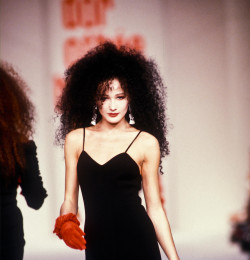

Dorothee Bis
Paris, 75006
France
About
founded by
Elie and Jacqueline Jacobson
belongs to
Naf Group
about
Dorothee Bis, the Paris ready-to-wear house, is a chain of stores opened in 1962 in Paris, and later in the USA, by Elie (born 1925) and Jacqueline Jacobson (born 1928). In the 1950's Jacqueline owned a childrenswear shop and Elie worked as a wholesale furrier. The house firmly established its now long-standing reputation for unusually stylish and wearable contemporary sportswear, particularly for knits of every variety and description.
The original boutique, Dorothée, was opened in 1958 by Elie Jacobson. Four years later, along with wife Jacqueline, they opened Dorothée Bis, a new concept in clothing boutiques that catered to young people and employed young people who wore the same clothes as the shoppers. Since then, the firm has been presenting clothes that manifest contemporary trends in a sophisticated and wearable way.
Dorthee Bis stores sold adult versions of young girls clothing, knee socks, peaked caps, cut-out dresses and trouser suits.
The Look
Easy fashion with all-over chic appeal. The kind of clothes that you know look right. Anytime, anyplace.
Dorothée Bis was among the first houses to present styles such as the long and skinny maxi look in knit coats and vests in the late 1960s, the peasant look in the early 1970s, the layered look in the mid-1970s, and the graphic color block look of the late 1970s and early 1980s. Generally, these looks were presented in a particularly Parisian way, as total ensembles (as opposed to the American idea of mix-and-match), with coordinating accessories—such as a knit dress and coat shown with a hand-knit shawl and beret in the same yarn with matching belt, bag, and fashion jewelry. Materials came from as far away as Nepal, India, and China.
Indeed, in 1969 and 1970, while the hemline debate was fought by other designers, Jacobson satisfied her customers' shifting desires by giving them the mini, the midi, and the maxi, all in the same collection. By 1972, those debating skirt lengths had reached a momentary consensus at mid-knee, leaving the design agenda open for a new focus on silhouette.
In the 1980s, with the rise of conservatism in culture and politics, there was a return to conventionally body-revealing fashions. Many women began to feel that in their adherence to orthodox feminism, they had abdicated the power inherent in their sexuality, and sought to regain that sense of power through their dress. Dorothée Bis was right in step with this trend with a new focus on dresses, especially in the firm's signature knits. A typical Dorothée Bis outfit of the period, a navy-and-white striped wool knit two-piece dress with deep V-neckline and padded shoulders.
Dorothee Bis Fashion Shows
